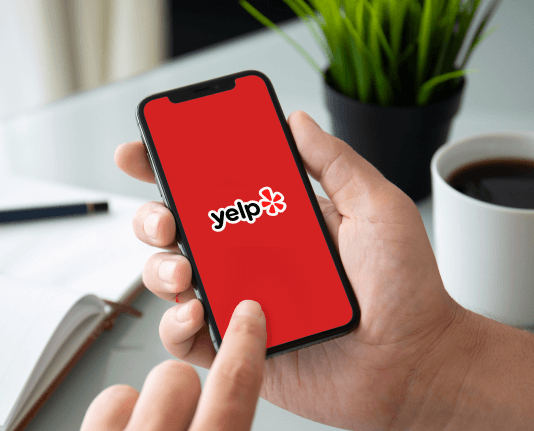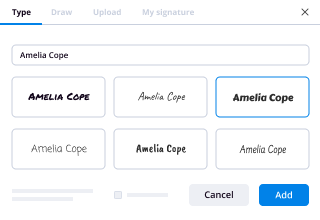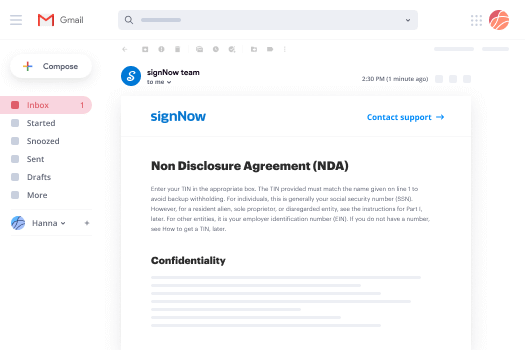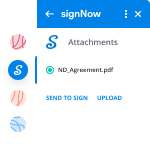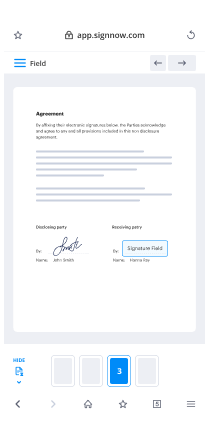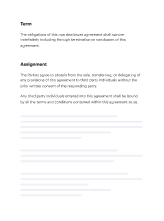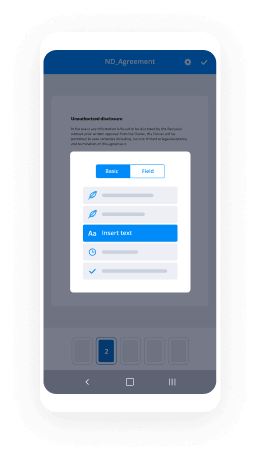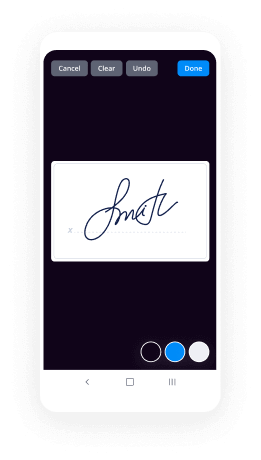Help Me With Integrate Sign in Word
Contact Sales
Make the most out of your eSignature workflows with airSlate SignNow
Extensive suite of eSignature tools
Discover the easiest way to Integrate Sign in Word with our powerful tools that go beyond eSignature. Sign documents and collect data, signatures, and payments from other parties from a single solution.
Robust integration and API capabilities
Enable the airSlate SignNow API and supercharge your workspace systems with eSignature tools. Streamline data routing and record updates with out-of-the-box integrations.
Advanced security and compliance
Set up your eSignature workflows while staying compliant with major eSignature, data protection, and eCommerce laws. Use airSlate SignNow to make every interaction with a document secure and compliant.
Various collaboration tools
Make communication and interaction within your team more transparent and effective. Accomplish more with minimal efforts on your side and add value to the business.
Enjoyable and stress-free signing experience
Delight your partners and employees with a straightforward way of signing documents. Make document approval flexible and precise.
Extensive support
Explore a range of video tutorials and guides on how to Integrate Sign in Word. Get all the help you need from our dedicated support team.
Keep your eSignature workflows on track
Make the signing process more streamlined and uniform
Take control of every aspect of the document execution process. eSign, send out for signature, manage, route, and save your documents in a single secure solution.
Add and collect signatures from anywhere
Let your customers and your team stay connected even when offline. Access airSlate SignNow to Integrate Sign in Word from any platform or device: your laptop, mobile phone, or tablet.
Ensure error-free results with reusable templates
Templatize frequently used documents to save time and reduce the risk of common errors when sending out copies for signing.
Stay compliant and secure when eSigning
Use airSlate SignNow to Integrate Sign in Word and ensure the integrity and security of your data at every step of the document execution cycle.
Enjoy the ease of setup and onboarding process
Have your eSignature workflow up and running in minutes. Take advantage of numerous detailed guides and tutorials, or contact our dedicated support team to make the most out of the airSlate SignNow functionality.
Benefit from integrations and API for maximum efficiency
Integrate with a rich selection of productivity and data storage tools. Create a more encrypted and seamless signing experience with the airSlate SignNow API.
Collect signatures
24x
faster
Reduce costs by
$30
per document
Save up to
40h
per employee / month
Our user reviews speak for themselves






Assist me with it: Uncover the advantages of airSlate SignNow
If you're looking for a dependable eSignature platform, airSlate SignNow can assist me with it. This service provides various advantages that simplify document signing procedures for enterprises of all sizes. From affordable pricing to outstanding support, airSlate SignNow is crafted to improve your workflow.
Assist me with it: Steps to utilize airSlate SignNow effectively
- Launch your web browser and go to the airSlate SignNow homepage.
- Sign up for a free trial or log into your current account.
- Choose the document you want to sign or send for signature and upload it.
- To save time in the future, transform your document into a reusable template.
- Access the uploaded file to make necessary adjustments, such as including fillable fields or other details.
- Add your signature and insert signature fields for the recipients' ease.
- Click 'Continue' to set up and send the eSignature invitation.
In summary, airSlate SignNow enables businesses to effectively send and eSign documents. With a comprehensive feature set that provides excellent ROI, it guarantees that you receive the maximum value for your investment.
Prepared to optimize your document management process? Try airSlate SignNow today and witness its benefits firsthand!
How it works
Search for help me with it
Familiarize with integrate sign
Save the signed document or share it with others
Rate your experience
-
Best ROI. Our customers achieve an average 7x ROI within the first six months.
-
Scales with your use cases. From SMBs to mid-market, airSlate SignNow delivers results for businesses of all sizes.
-
Intuitive UI and API. Sign and send documents from your apps in minutes.
A smarter way to work: —how to industry sign banking integrate
FAQs
-
How can airSlate SignNow help me with it if I'm new to eSigning?
If you're new to eSigning, airSlate SignNow can help me with it by providing a user-friendly interface that simplifies the signing process. Our platform offers step-by-step guidance to help you send and sign documents quickly. Plus, our extensive support resources are available to assist you whenever you need help.
-
What pricing options does airSlate SignNow offer for businesses?
airSlate SignNow offers flexible pricing plans that can help me with it, whether you’re a small business or a large enterprise. We provide various tiers to suit different needs, ensuring you only pay for the features you require. Check out our pricing page for detailed information on what each plan includes.
-
Can airSlate SignNow help me with it if I need to integrate with existing software?
Absolutely! airSlate SignNow can help me with it by seamlessly integrating with popular software such as Salesforce, Google Drive, and Zapier. This allows you to streamline your workflow and enhance productivity by connecting your eSigning process with tools you already use.
-
What features does airSlate SignNow provide to enhance document security?
To enhance document security, airSlate SignNow can help me with it by offering features like advanced encryption, secure cloud storage, and customizable access controls. These features ensure that your sensitive documents remain protected throughout the signing process, giving you peace of mind.
-
How quickly can I get started with airSlate SignNow?
Getting started with airSlate SignNow is quick and easy! In just a few minutes, you can create your account, upload documents, and start sending them for eSignature. If you need assistance, our support team can help me with it to ensure a smooth onboarding experience.
-
Does airSlate SignNow provide mobile access for on-the-go signing?
Yes, airSlate SignNow provides mobile access that can help me with it when you need to sign documents on the go. Our mobile app is designed for convenience, allowing you to send and sign documents anytime, anywhere, ensuring you never miss a deadline.
-
What customer support options does airSlate SignNow offer?
airSlate SignNow offers various customer support options to help me with it, including email support, live chat, and an extensive knowledge base. Our dedicated support team is always ready to assist you with any questions or issues you may encounter.
-
What is an intuitive explanation of the Fundamental Theorem of Calculus?
Derivative [math]\part[/math] is the opposite of integral [math]\int[/math].That's essentially because plus is the opposite of minus. (and minus the opposite of plus)Like [math]\arcsin[/math] is the opposite of [math]\sin[/math] or like [math]\ln[/math] is the opposite of [math]\exp[/math]. These pairs of functions are each other's undoing, although if you look carefully each comes with caveats.The "deep story" of the FTC is found in Green's theorem, Stokes' theorem, and Gauss-Ostrogradsky divergence theorem—or finally (?) in Élie Cartan's world of differential forms and geometric algebra / Grassmanians. Most of that is too abstract if you're just asking about the FTC. But one physical intuition that comes from the 3-D version can be helpful in understanding the 1-D FTC.Imagine a lake full of water, with only one boundary in and one boundary out. (Assume no evaporation or rain, although you could add that in. The equation would have a few more terms but be conceptually the same. However I don't want to explain the extra terms.) The volume ([math]\int[/math]) of the lake is fixed unless we lose it through the outlet (change = [math]\part[/math]) or gain it through the inlet (change = [math]\part[/math]).Call the inlet [math]a[/math] and the outlet [math]b[/math]. After we've initially figured out the volume of water in the lake [math]V_0[/math] we could just measure the inlet [math]a[/math] and the outlet [math]b[/math] and figure out the volume of the lake. [math]\int_a^b \texttt{changes} \quad + V_0[/math] Just by watching the entrance and exit we'd know if any water entered or left the lake.I won't make the connection explicit but this story of lake with inlet & outlet is giving you the intuition of "higher versions of the FTC" without the higher-level vocabulary.
-
What's the history of the “Awesome Button” (that eventually became the Like button) on Facebook?
July 13, 2007 - In the initial email discussion about a project codenamed "Props" between me, Justin Rosenstein , Leah Pearlman, Ezra Callahan, and Akhil Wable, we boil down the discussion of symbols to: - stars (concern that it would translate to "I give this 1 star" which is a bad review) - plus sign (possibly accompanied with a minus sign, apropos to this discussion) - thumbs up (concern about internationalization, this is a bad sign in some places) We also consider lots of language and settle, temporarily, on "awesome." July 17, 2007 - At a Hackathon, Tom Whitnah, Justin Rosenstein, Olaoluwa 'Ola' Okelola, Rebekah Cox and I build a working initial prototype of the "awesome button," complete with integration into News Feed and Mini Feed. July 19, 2007 - the longer process of design begins with Aaron Sittig, Rebekah Cox, along with Katie Geminder. July 31, 2007 - In a larger set of threads, the project builds a huge amount of interest: - James Wang and platform product marketing are interested because of the potential to use awesome button to filter out bad application stories. - Feed team interested in improving feed ranking - Ads team interested in improving CTR August 17, 2007 - Alexandre Roche delivers comprehensive design mocks. August 22, 2007 - the word "like" is proposed as a more universal term but receives a lukewarm response. We've become somewhat attached to awesome and, comparatively, like seems bland. Carolyn Abram starts getting involved in language choices. September 26, 2007 - the project slows to a crawl as we search for a UI that fits in too many places on the site (platform, adds, feed, content). October 30, 2007 - Friendfeed adds "like" feature. As far as I can tell from my email archives, nobody at FB noticed. =/ November 12, 2007 - Ready to launch and things appear to be all set but final review with Zuck surprisingly doesn't go well. Concerns about the whether the interaction is public or private, cannibalizing from the share feature, and potential conflict with Beacon. Feature development as originally envisioned basically stops. November 14, 2007 - The feature is temporarily exposed to users due to a bug. December 2007 - November 2008 - The News Feed and Ads teams both launch small scale implementations that accept both positive and negative feedback but apply that information privately to the user and do not share it socially. The news feed system proves ineffective and is ultimately shut down. The ads team implementation worked on by Jared Morgenstern and Kent Schoen helps demonstrate that clicks do not always correlate with a user supplied quality score, which helps refine the ads system and drives confidence in a new signal. December 2008 - February, Jonathan Pines as lead engineer, Jared Morgenstern as product manager, and Soleio take on the project. The project was considered a cursed project because it had failed so many Zuck reviews. In order to combat that the team enlisted Itamar Rosenn to arm the team with data to prove the presence of a Like button did not take away from the number of the comments that a post received. In fact when the early tests came back it turned out that the presence of the Like button increased the number of comments due to how News Feed using Like as a signal for distribution. Roll out to 100% of users followed shortly. February 9, 2009 - Facebook launches "like" and Leah Pearlman writes her blog post "I like this" to announce it to the world, recognizing her hard work at the inception of the project and her support throughout it. The world immediately accuses Facebook of stealing the the idea from Friendfeed.
-
What is the best website very few people know about? What's great about it?
1 Couchsurfing:If you travel a lot over to new places, this is the website to make memories. It’s a social network to meet locals in new places and experience the place from their angle. You can invite people to stay with you at your place as a host.2. How Stuff Works: Well, the name says it all. How Stuff works gives you the insights into different processes. Be it something as easy as how does an IP protocol works or how does Alcohol affects your body, I binge read the website for hours. I love how they have linked the website to each other.3. Spreeder: Spreeder teaches you to read faster and understand things quickly. It will for sure make you productive with time.4. Highbrow: Highbrow is an website that provides you daily lessons on different topics ranging from Productivity to Business to Technology. You can find all sorts of lessons delivered to your mailbox every morning. Every lesson is worth 5 minutes of your time and you cannot subscribe to more than one course at a time as it will play with your attention.5. StumbleUpon: StumbleUpon is a place where you literally stumble upon things. Choose your interests from the list and click on the stumble upon icon which looks like ohm. Every time you will be presented with an article, image, infographic or video from all over the web. You will be presented with cool stuff all the time.6. Nerd Fitness: There is a lot of bullshit regarding fitness out there. These guys are helping you out with all that. Videos, Blogs and Training regimes for nerds, jockeys and everyone who wants to level up their game in fitness. This site has taught me how small lessons can boost up your life with exercise. There is a lot of free stuff on the website that you can get help from.7. Cooking for Engineers : Cooking for Engineers is again a cooking site for nerds. There’s a technical twist to cooking on this website. All the recipes and ingredients are analysed for best results. If you like cooking with everything to be perfect with accurate facts, go visit this website now.8. Information is beautiful: If you’re bored of information in just text format, visit this website. This website provides information on various topics in beautiful pictures, charts and infographics. You can roam around on website for hours and never get bored.9. Duolingo: Duolingo is a great website to learn new languages. You will have to be persistent with the website in order to learn a new language here and over time you will see the results. It’s fun to learn new language on this website(or App).10. Lumosity: Learning new things via games has been fun since Kindergarten and this website is just the same. You can learn calculations, improve your vocabulary and much more on this website.11. Khanacdemy: What started off as a teaching program for cousins ended up into one of the biggest knowledge store for users all around the world. Khanacademy has a collection of usefull video lessons on various topics ranging from Maths to Economics and the best part is: It’s totally free since it’s non-profit.12. Codeacademy: Have you ever tried to learn a new programming language but ended up only cramming text from books and never got to the practical part. This is where Codeacademy comes in. Choose your language and start practicing on it. There are lessons first, then assignments and if you are struck, help is always around the corner. If you’re just started programming in college or thinking of taking programming as a career, try this website. You will love it.13. Grammarly: Grammarly is an online website which looks out for grammatical errors in your writing. It has a pretty cool browser extension that sorts out mistakes in your emails or wherever you’re writing. If you’r serious about writing and cannot afford a writer, their pro version will do the job.
-
When did you have to argue with your child's school?
Obligatory not me.. But my mother—My dad was military, so my brothers and I went to base schools up until he was discharged. We also went to military doctors.The first time I remember mom going up to the school other than to drop off projects/food/ treats for our classrooms was when I was in 3rd grade. I had a new teacher, new to teaching. She was a military personnel, and had never worked with kids with any type of disabilities.Unfortunately, my class was her guinea pig. I have ADHD.. But instead of hyper, I'm hypo.. As in, I can sit still for hours, and stare at you, and not hear a single...
-
Why is that people of Karnataka and Tamil Nadu are paranoid about the language while in Andhra, you won't hear much about saving
There are two main reasons: Apathy and History.ApathyI am sorry to say that Telugus just don’t care too much about issues if they do not impact their bottom line in terms of economics and finances. We are one of the least chauvinistic people when it comes to language, and will be accommodating to other cultures so long as Telugu is accorded respect. There is also a level of a self-imposed complex because Telugus, generally, find it more upscale and “cool” to speak English or Telugu heavily laced with English. There is a saying I have heard of recently that applies to modern Telugus: “When two Telugu people meet, they speak in English.” I would say this is true to an extent; at the least, they will use Telugu heavily laced with English.Telugus do have pride that our language was questioned by Rabindranath Tagore; he asked if Telugu was a language or music because it is very sweet to the tongue and ear. If push comes to shove and we feel our language is being threatened, we will pushback. But overall, we do not place a higher emphasis on language assertion because the vast majority of Telugus, in all castes and of all status, believe that being flexible and accommodating has its benefits. We do have people, such as myself, who are vigilant about Telugu’s status or the government’s actions involving language policy; however even we are not at as active nor as protective anywhere near the levels that Tamils, Kannadigas, and Bengalis are about their language.I think to summarize what I have said, I asked my wife why Telugus are more easy-going about this issue: She opined that for “Telugu walla ki Bhasha abhimanam, vividha rashtra walla ki Bhasha ahankaram.” (Telugu people have pride in their language, while people of other states are arrogant about their language). [Note: She used the people of other states in the context of linguistic chauvinists. She was not implying that the majority of people in one state or region are like that.]I want to make two points from this statement. First, there are many Telugus who will agree with what she said. Second, the words she used in her sentence leads me to my next point.History:If you notice my wife’s response, many people versed in other Indian languages will pick up on some words. Unknowingly and without intent, my wife gave me a response in Telugu with almost ALL the words derived from Sanskrit or Prakrit. The very word Telugu is believed to be derived from a Sanskrit word, Trilinga. This leads me to the point about history.Telugu has been influenced since 2,500 years or so, since the Assaka Vedic Mahajanapada, from Sanskrit and Prakrit. The Telugu lands have been constantly ruled by rulers who solely patronized other languages, like Sanskrit, Odia, Prakrit, Kannada, Tamil, and Urdu.” Even the Telugu rulers who patronized Telugu did it in conjunction with Sanskrit or Prakrit. Even during the Rashtrakuta rule (Kannada) and the Chola rule (Tamil) of Telugu regions, Sanskrit was patronized by the rulers.The major point I am getting across is that Telugu has been shaped by many languages, especially Sanskrit, Prakrit, and during the Muslim rule, Urdu. So linguistic chauvinism, on either side of the debate, does not resonate with the vast majority of Telugu people and hasn’t for millenniums. Now I am sure someone will comment that Kannada is also similarly shaped by other languages, so why have they been louder about this issue?Like Telugus, Kannadigas have been accommodating to other cultures. However, that accommodation has led to several noticeable incidents including the metro signs issue, government workers who demand that Kannadigas speak to them in Hindi, despite the government workers working in Karnataka, and even certain banks not having forms in Kannada.Who would not be mad at that? I would love to see the reaction of some people condoning what happened in Karnataka when, hypothetically, Delhi government workers demand locals to speak to them in Bengali or when Delhi banks only have forms in Tamil and English.Thankfully, Telugus have, to a vast extent, been spared from these situations in Karnataka; perhaps due to our large population. There have been some instances where this has happened, but the issues have been dealt with minimal fuss and with speed. These are pictures from across Telugu states and in all areas that show the harmonious integration of languages in public spaces:(Hyderabad Metro Signs in Telugu, English, Hindi, and Urdu)(Nizamabad Sign in Telugu, Hindi, English, and Urdu)(Telugu, Hindi, and English at Vishakapatnam)I have been told by many that Vishakapatnam also has many Odia signs for Odia people that come or visit the city.(Telugu, English, Tamil, Kannada, and Hindi in a sign in Tirupati)These are anecdotal examples to show that Telugus will respect and accommodate other languages in our region. The Telugus, with our pride in our language, have set a national example, in my view. Accommodate, learn, and respect as many languages as feasible, while standing against linguistic chauvinism on both sides of the issue and imposition of one language over Telugu. We do not hate people from other regions or our neighboring states. We are and will always be proud to be the people that gave India her national flag. We are proud Indians and Telugus.P.S: While we are flexible and accommodating, we strongly request and recommend that non-Telugus moving to our states learn Telugu. We do or try to do the same when we move to other states. For instance, my son and daughter-in-law, both Telugus who now live in Bengaluru, learned Kannada when they moved from Hyderabad about 6 years ago. Hindi is also taught in both AP and Telangana schools with no fusses. So, reciprocate that.As my wife said, don't have ahankara (arrogance) in believing your language is better than another. Learn and respect the language of the locals. Do not give excuses like “it's too hard to learn” or “my language should be the nation's lingua franca, so why should I bother to learn another.” We do not wish for cities to turn into Mumbai, in regards to language, where a beautiful language of the Deccan, Marathi, has been almost completely sidelined. If you are just visiting, pick up on some basic phrases so that you can ask for help, especially if you are planning to go outside of urban centers.Treat every language with respect and don’t be arrogant (applies to chauvinists on all sides) that your language is more to superior to another. A language is a tool of communication - the more tools that are available for the public, the better for everyone. So, learn the local language as well, and Hindi is also a useful language to learn. Let’s preserve India’s language diversity.
-
What are some interesting startups in the education space? Why are they interesting?
Here's one noteworthy peer-to-peer education model in Paris newly opened in November 2013 to students around the world, tuition FREE! — École 42 — The school, housed in a former government building used to educate teachers (ironically enough), was started by Xavier Niel. The founder and majority owner of French ISP Free, Niel is a billionaire many times over. He’s not well known in the U.S., but here he is revered as one of the country’s great entrepreneurial successes in tech. This French Tech School Has No Teachers, No Books, No tuition — And It Could Change EverythingAbove: Nicolas Sadirac, the director of the ambitious, free, French tech school Ecole 42. Image Credit: Dylan Tweney/VentureBeatNicolas Sadirac, a French entrepreneur and educator, is the school’s director. Before École 42 he ran Epitech, a well-regarded, private, for-profit school that trained software engineers.PARIS — École 42 might be one of the most ambitious experiments in engineering education.It has no teachers. No books. No MOOCs. No dorms, gyms, labs, or student centers. No tuition.And yet it plans to turn out highly qualified, motivated software engineers, each of whom has gone through an intensive two- to three-year program designed to teach them everything they need to know to become outstanding programmers.The school, housed in a former government building used to educate teachers (ironically enough), was started by Xavier Niel. The founder and majority owner of French ISP Free, Niel is a billionaire many times over. He’s not well known in the U.S., but here he is revered as one of the country’s great entrepreneurial successes in tech. He is also irrepressibly upbeat, smiling and laughing almost nonstop for the hour that he led a tour through École 42 earlier this week. (Who wouldn’t be, with that much wealth? Yet I have met much more dour billionaires before.) Niel started École 42 with a 70 million euro donation. He has no plans for it to make money, ever.“I know one business, and that’s how to make software,” Niel said. “I made a lot of money and I want to give something back to my country,” he explained.To make the school self-sustaining, he figures that future alumni will give back to their school, just as alumni of other schools do. If a few of them become very rich, as Niel has, perhaps they, too, will give millions to keep it going.The basic idea of École 42 is to throw all the students — 800 to 1,000 per year — into a single building in the heart of Paris, give them Macs with big Cinema displays, and throw increasingly difficult programming challenges at them. The students are given little direction about how to solve the problems, so they have to turn to each other — and to the Internet — to figure out the solutions.The challenges are surprisingly difficult. One student I talked with was coding a ray tracer and building an emulation of the 3-D dungeon in Castle Wolfenstein within his first few months at the school. Six months earlier, he had barely touched a computer and knew nothing of programming. He hadn’t even finished high school.In fact, 40% of École 42′s students haven’t finished high school. Others have graduated from Stanford or MIT or other prestigious institutions. But École 42 doesn’t care about their background — all it cares about is whether they can complete the projects and move on. The only requirement is that they be between the ages of 18 and 30.“We don’t ask anything about what they’ve done before,” Niel said.Yet École 42 is harder to get into than Harvard: Last year, 70,000 people attempted the online qualification test. 20,000 completed the test, and of those, 4,000 were invited to spend four weeks in Paris doing an intensive project that had them working upwards of 100 hours a week on various coding challenges. In the end, 890 students were selected for the school’s inaugural class, which began in November, 2013. (The average age is 22, and 11 percent of the first class is female.)890 students out of 70,000 applicants means an acceptance rate a little north of 1%, or if you only count those who completed the test, 4.5%. By contrast, Harvard accepts about 6% of its applicants. And, even with financial aid, it charges a whole lot more than ZERO for its classes.The upshot: If it works, the school’s course of education will produce coders who are incredibly self-motivated, well-rounded in all aspects of software engineering, and willing to work hard. (The four-week tryout alone, with its 100-hour weeks, blows away the French government’s official 35-hour-work week.)All of École 42′s projects are meant to be collaborative, so the students work in teams of two to five people. At first glance, the École’s classrooms look a little bit like a factory floor or a coding sweatshop, with row after row of Aeron-style chairs facing row after row of big monitors. But a closer look reveals that the layout is designed to facilitate small-group collaboration, with the monitors staggered so that students can easily talk to one another, on the diagonals between the monitors or side by side with the people next to them. Students can come and go as they please; the school is open 24 hours a day and has a well-appointed cafeteria in the basement (with a wine cellar that can hold 5,000 bottles, just in case the school needs to host any parties).Students share all of their code on Github (naturally). They communicate with one another, and receive challenges and tests, via the school’s intranet. Everything else they figure out on their own, whether it means learning trigonometry, figuring out the syntax for C code, or picking up techniques to index a database.Tests are essentially pass-fail: Your team either completes the project or it doesn’t. One administrator compared it to making a car: In other schools, getting a test 90% right means an A; but if you make a car with just three out of four wheels, it is a failure. At École 42, you don’t get points for making it part way there — you have to make a car with all four wheels.The no-teachers approach makes sense, as nearly anything you need to know about programming can now be found, for free, on the Internet. Motivated people can easily teach themselves any language they need to know in a few months of intensive work. But motivation is what’s hard to come by, and to sustain — ask anyone who has tried out Codecademy but not stuck with it. That has prompted the creation of “learn to code” bootcamps and schools around the world. École 42 takes a similar inspiration but allows the students to generate their own enthusiasm via collaborative (and somewhat competitive) teamwork.Sadirac and Niel say that some prestigious universities have already expressed interest in the school’s approach. The two are considering syndicating the model to create similar schools in other countries.But even if they never expand beyond Paris, École 42 could become a signNow force in software education. France already has a reputation for creating great engineers (in software as well as in many other fields).If École 42 adds another thousand highly-motivated, entrepreneurial software engineers to the mix every year, it could very quickly accelerate this country’s competitiveness in tech.And the model will force schools like Harvard to make an extra effort to justify their high tuitions. If you can get training like this for free, and you want to be a software engineer, why go to Harvard?(news link:) This French tech school has no teachers, no books, no tuition -- and it could change everything
-
What is it like to be the only Deaf person in a hearing family?
I am completely qualified to answer this. I am the only deaf person in the entire family tree of mine. From my parents point of view, it was scary and confusing for them, not because of the disability but because they didn't know how to guide me or how to bring me up. But luckily, they received tons of supports and so they somehow found the right persons to connect and help me be the person I am today. They know I am also human, and never actually treated me differently. Maybe that's the reason I never knew I was different in the early stages of my life. After repeatedly contact with the outside world, only I did come to know that we weren't the same as others. I infact, believed that all of us, normal hearing and deaf people used to talk with lips movement like I just did. When we all were kids, my cousins and other friends of mine used to whisper stuffs into my ears, like everyone does. I used to feel puzzled that what are they saying, I used to let it off. I thought it's nothing. Later only I realised its people were talking about something. That time I made sure to let people know to talk face to face and not to whisper into my ears, as it would have been of no use. Basically it's both a rewarding experience as well as a learning experience for me. It's then I realised that I do have parents and family as supports, but I can't expect them to find all the answers for me as they are also learning it along with me. I had to learn to find those by myself. They (my parents and my close family) have tried their best to make my life easier, by talking in English to me, and conversing to me with the help of social medias like WhatsApp, messaging. They even try to ensure if subtitles are happening for the particular movie we plan to watch in theatre. My aunts (like my parent's sisters, or their brother's wife) try their best to converse with me in English, and they keep lamenting for not having learnt proper English. I try my best to convince them that's it's alright, I really appreciate their efforts. It's actually my family who has been really supportive in this journey of mine. I do thank god for having received an amazing family. My parents let me know beforehand, that I would definitely have to do hardwork, but I always left it aside. Now though I know the value of hardwork. I used to believe that if I weren't deaf, my life would be easier. But then I realised, life being easier isn't full of sunshine, it tends to get boring after a while. Came to the conclusion that life should be a mixture of Hardwork and relaxation too. Every single and small achievements of mine are recorded in my family mind. Few Hindi words spoken is a delight for them. Or if I achieve something related to hearing stuff, they express their happiness. They know it's not taken for granted. Couple of things happened after I joined this family. ->Made English language a part of daily conversations, not just Hindi. ->Let everyone know that I am actually normal, and made me comfortable in the atmosphere. ->Taught me to live comfortably and manage in this world.->Taught that impossible is just a word. ->Even my younger brother looks up to me, I don't think he knows that I actually have a disability. ->Learnt that I am a good human being. ->Learnt that family and close friends will stand by you, for anything. ->Oh yeah, how could I forget the overprotective shell I am in, created by my parents. Basically it's an amazing journey for me.
-
How do I set up a form that sends an SMS to a user when they enter their phone number?
You will require to Integrate your system to a bulk SMS API that will help you send an SMS to the user when they enter their phone number. I would suggest you check out Textlocal API they have their API available in 11 major languages which are PHP, Java, C#, Python, .Net, Ruby and more. The best part is that they have their API available for free and also have a detailed explanation how to integrate their API to an APP and a website. If you have any problem with integrating their API you can always call the support team they will be more than happy to help you out. Let me tell you a few ad...
-
Have you ever tried Grammarly?
Yes, I did.In fact, I bought the Premium version of Grammarly with 61% discount code and using it for the last one year.Grammarly always corrects my spelling and punctuation errors which used to screw up the beauty of my contents.And it also helps me to correct my word usages, convention, and sentence structures to keep my writing in line with a genre specific style.Besides, their integrated dictionary which can be personalized as well helps me to use the most appropriate and suitable words, synonyms, and adjectives for my contents.And the plagiarism feature of Grammarly always gives me a quick alert as soon as a duplicate content is found in my writing.So yes, I DID try and fall in love with Grammarly. And I now have it added to my Chrome browser and Microsoft Word.So just sign up today and try out the free version of Grammarly. If it suits your tastes and budget, you can then opt for the premium one which helps you get your writing inspected for over 400+ grammatical issues.Here’s the link Grammarly - Your Free Writing Assistant.Hope this helpsCheers…
Trusted esignature solution— what our customers are saying
be ready to get more
Get legally-binding signatures now!
Related searches to Help Me With Integrate Sign in Word
How to type integral symbol in mobile keyboard
How to type integral symbol With limits in Word
Integration symbol With limits
How to type integral symbol in Word
Integration symbol name
Integration symbol text
Double integral symbol
How to write integral symbol on computer
Frequently asked questions
How do i add an electronic signature to a word document?
When a client enters information (such as a password) into the online form on , the information is encrypted so the client cannot see it. An authorized representative for the client, called a "Doe Representative," must enter the information into the "Signature" field to complete the signature.
What is a live electronic signature?
The signature of an authentic document is generated when an electronic signature (a code, symbol, or a fingerprint) is applied to a digital document. The signature is verified by the electronic signatures of the addressee and the addressees.
The key element of a live electronic signature is the signature code or digital identity code.
For instance, an official certificate is issued by the Ministry of Health when the applicant's birth certificate is submitted to the Ministry, but the Ministry is also the official who verifies the signature code. There are several factors that affect the strength of one's electronic signature.
For instance, the electronic signature is based on a key system that is used to authenticate the signature. A key system is a combination of a signature code, signature algorithm, and cryptographic algorithm. These factors affect different aspects of the signature code and its verification. The most important is the signature algorithm, which is a way to generate random numbers that produce different signature code numbers.
This method of generating random numbers can be used to prevent duplicate signatures or to generate unique signatures by the same person to prove they are the same person. It can also be used to ensure the validity or authenticity of documents with similar signatures.
An electronic signature is only as strong as the algorithm, which includes the key system, but the strength of a computerized key system can also affect the strengt...
On netflix sign in page, how do i change incorrect e-mail address?
A: We have recently switched to a new system that does not allow us to change your email address.
Q: What is your refund policy?
A: We offer a 7 DAY FREE RETURN POLICY. This means we will automatically refund all of the cost of your order upon your request in seven days unless otherwise stated.
Q: Why do you offer Free Shipping, if you only sell on eBay?
A: We currently sell on eBay and Amazon but we are not currently offering Free shipping on orders placed on Etsy because our current system does not allow for free e-commerce shipping through Etsy.
Q: I am looking for a gift for my son or daughter and they don't seem to be interested. What do I do?
A: If you are looking for a gift and your recipient is not interested, they have two options. They can either purchase it online for you through Etsy or send a check or money order in the mail to us at:
We are happy to provide gift certificates if the recipient chooses this option.
Get more for Help Me With Integrate Sign in Word
- How To Electronic signature Idaho Insurance POA
- Can I Electronic signature Illinois Insurance Last Will And Testament
- Electronic signature High Tech PPT Connecticut Computer
- Electronic signature Indiana Insurance LLC Operating Agreement Computer
- Electronic signature Iowa Insurance LLC Operating Agreement Secure
- Help Me With Electronic signature Kansas Insurance Living Will
- Electronic signature Insurance Document Kentucky Myself
- Electronic signature Delaware High Tech Quitclaim Deed Online
Find out other Help Me With Integrate Sign in Word
- Application water service form
- Transcript of nail care apprentice training it is hereby form
- Nh application permit fire form
- Wsp request for expungement form
- 8th grade social studies syllabus highline public schools highlineschools form
- Pre application meeting request form
- Fillable online auction procurement form sacred heart parish fax
- Mobile food facility permit application renton farmers market form
- Washington department of agriculture pesticide application form
- Triangle aquatic center emergency action plan form
- Public records request washington state department of financial dfi wa form
- Text of h r 10104 89th an act to enact govtrack us form
- General information craven county government
- Dancingwheelz merch form
- Ohio deck permit city form
- Ovr tournament entry form
- Sign permit application boardman township form
- D49 state assessment opt out request form
- Bravotroyohio comthe float troy experience pthe float troy experience form
- Client health history lash extensions form



